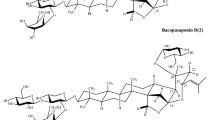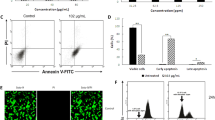Abstract
Natural products have become increasingly important in pharmaceutical discoveries, and traditional herbalism has been a pioneering specialty in biomedical science. The search for effective plant-derived anticancer agents has continued to gain momentum in recent years. The present study aimed to investigate the role of crude extracts of the aerial parts of Artemisia absinthium (AA) extract in modulating intracellular signaling mechanisms, in particular its ability to inhibit cell proliferation and promote apoptosis in a human breast carcinoma estrogenic-unresponsive cell line, MDA-MB-231, and an estrogenic-responsive cell line, MCF-7. Cells were incubated with various concentrations of AA, and anti-proliferative activity was assessed by MTT assays, fluorescence microscopy after propidium iodide staining, western blotting and cell cycle analysis. Cell survival assays indicated that AA was cytotoxic to both MDA-MB-231 and MCF-7 cells. The morphological features typical of nucleic staining and the accumulation of sub-G1 peak revealed that the extract triggered apoptosis. Treatment with 25 μg/mL AA resulted in activation of caspase-7 and upregulation of Bad in MCF-7 cells, while exposure to 20 μg/mL AA induced upregulation of Bcl-2 protein in a time-dependent response in MDA-MB-231 cells. Both MEK1/2 and ERK1/2 was inactivated in both cell lines after AA treatment in a time-dependent manner. These results suggest that AA-induced anti-proliferative effects on human breast cancer cells could possibly trigger apoptosis in both cell lines through the modulation of Bcl-2 family proteins and the MEK/ERK pathway. This might lead to its possible development as a therapeutic agent for breast cancer following further investigations.







Similar content being viewed by others
References
Koul MK (1997) Medicinal Plants of Kashmir and Ladakh, Temperate and Cold Arid Himalaya, Indus Publishing Company, FS-5, Tagore Garden, New Delhi p 102, ISBN: 81-7837-061-6
Juteau F, Jerkovic I, Masotti V, Milos M, Mastelic J, Bessiere JM, Viano J (2003) Composition and anti-microbial activity of essential oil of Artemisia absinthium from Croatia and France. Planta Med 69:158–161
Saban K, Recep M, Ahmet CAA, Ali Y (2005) Determination of the chemical composition and antioxidant activity of the essential oil of Artemisia dracunculus and of the antifungal and antibacterial activities of Turkish Artemisia absinthium, Artemisia dracunculus, Artemisia santonicum, and Artemisia spicigera essential oils. J Agric Food Chem 53:9452–9458
Meschler JP, Howlett AC (1999) Thujone exhibits low affinity for cannabinoid receptors but fails to evoke cannabimimetic responses. Pharm Biochem Behav 62:413–480
Baytop (1984) Therapy with Medicinal Plants in Turkey. Istanbul University Press, Istanbul, pp 166–167
Jo EH, Kim SH, Ra JC, Kim SR, Cho SD, Jung JW et al (2005) Chemopreventive properties of the ethanol extract of Chinese licorice (Glycyrrhiza uralensis) root: induction of apoptosis and G1 cell cycle arrest in MCF-7 human breast cancer cells. Cancer Lett 230:239–247
Wu CC, Chan ML, Chen WY, Tsai CY, Chang FR, Wu YC (2005) Pristimerin induces caspase-dependent apoptosis in MDA-MB-231 cells via direct effects on mitochondria. Mol Cancer Ther 4:1277–1285
Garcia-Carbonero R, Supko JG (2002) Current perspectives on the clinical experience, pharmacology, and continued development of the camptothecins. Clin Cancer Res 8:641–661
Rowinsky EK, Donehower RC (1995) Paclitaxel (taxol). N Engl J Med 332:1004–1014
Zhu JY, Lavrik IN, Mahlknecht U, Giaisi M, Proksch P, Krammer PH, Li- Weber M (2007) The traditional Chinese herbal compound rocaglamide preferentially induces apoptosis in leukemia cells by modulation of mitogen-activated protein kinase activities. Int J Cancer 121:1839–1846
Huang M, Gao H, Chen Y, Zhu H, Cai Y, Zhang X, Miao Z, Jiang H, Zhang J, Shen H, Lin L, Lu W, Ding J (2007) Chimmitecan, a novel 9-substituted camptothecin, with improved anticancer pharmacologic profiles in vitro and in vivo. Clin Cancer Res 13:1298–1307
Tamvakopoulos C, Dimas K, Sofianos ZD, Hatziantoniou S, Han Z, Liu ZL, Wyche JH, Pantazis P (2007) Metabolism and anticancer activity of the curcumin analogue, dimethoxycurcumin. Clin Cancer Res 13:1269–1277
Li L, Gao Y, Zhang L, Zeng J, He D, Sun Y (2008) Silibinin inhibits cell growth and induces apoptosis by caspase activation, downregulating surviving and blocking EGFR-ERK activation in renal cell carcinoma. Cancer Lett 272:61–69
Razis ED, Fountzilas G (2001) Paclitaxel: epirubicin in metastatic breast cancer–a review. Ann Oncol 12:593–598
Hainsworth JD, Greco FA (1995) Etoposide: twenty years later. Ann Oncol 6:325–341
Jordan MA, Thrower D, Wilson L (1991) Mechanism of inhibition of cell proliferation by Vinca alkaloids. Cancer Res 51:2212–2222
Ganry O (2002) Phytoestrogen and breast cancer prevention. Eur J Cancer Prev 11:519–522
Sun SY, Hail N, Lotan R (2004) Apoptosis as a novel target for cancer chemoprevention. J Natl Cancer Inst 96:662–672
Shafi G, Munshi A, Hasan TN, Alshatwi AA, Jyothy A, Lei DKY (2009) Induction of apoptosis in HeLa cells by chloroform fraction of seed extracts of Nigella sativa. Cancer Cell Int 9:29
Mans DRA, Da Rocha BA (2000) Schwartsmann G. Anti-cancer drug discovery and development in Brazil: target plant as a rational strategy to acquire candidate anti-cancer compounds. The Oncologist 5:185–198
Khan MR, Mlungwana SM (1999) c-sitosterol, a cytotoxic sterol from Markhamia zanzibarica and Kigelia africana. Fitoterapia 70:96–97
Panchal RG (1998) Novel therapeutic strategies to selectively kill cancer cells. Biochem Pharmacol 55:247–252
Ramos S (2007) Effects of dietary flavonoids on apoptotic pathways related to cancer chemoprevention. J Nutr Biochem 18:427–442
Williams GT, Smith CA (1993) Molecular regulation of apoptosis: Genetic controls on cell death. Cell 74:777–779
Marzo I, Naval J (2008) Bcl-2 family members as molecular targets in cancer therapy. Biochem Pharmacol 76:939–946
Chang J, Hsu Y, Kuo P, Kuo Y, Chiang L, Lin C (2005) Increase of Bax/Bcl-XL ratio and arrest of cell cycle by luteolin in immortalized human hepatoma cell line. Life Sci 76:1883–1893
Mohammad R, Giri A, Goustin AS (2008) Small-molecule inhibitors of Bcl-2 family proteins as therapeutic agents in cancer. Recent Pat Anti-cancer Drug Discov 3:20–30
Cha YY, Lee EO, Lee HJ, Park YD, Ko SG, Kim DH et al (2004) Methylene chloride fraction of Scutellaria barbata induces apoptosis in human U937 leukemia cells via the mitochondrial signaling pathway. Clin Chim Acta 348:41–48
Paris C, Bertoglio J, Breard J (2007) Lysosomal and mitochondrial pathways in milterfosine-induced apoptosis in U937 cells. Apoptosis 12:1257–1267
Han MH, Yoo YH, Choi YH (2008) Sanguinarine-induced apoptosis in human leukemia U937 cells via Bcl-2 downregulation and caspase-3 activation. Chemotherapy 54:157–165
Reed JC (1997) Double identity for proteins of the Bcl-2 family. Nature 387:773–776
Santen RJ, Song RX, McPherson R, Kumar R, Adam L, Jeng MH, Yue W (2002) The role of mitogen-activated protein (MAP) kinase in breast cancer. J Steroid Biochem Mol Biol 80:239–256
Motomura M, Kwon KM, Suh SJ, Lee YC, Kim YK, Lee IS (2008) Propolis induces cell cycle arrest and apoptosis in human leukemic U937 cells through Bcl-2/Bax regulation. Environ Toxicol Pharmacol 26:61–67
Sen S, D’Incalci M (1992) Biochemical events and relevance to cancer chemotherapy. FEBS Lett 307:122–127
Agarwal C, Sharma Y, Zhao J, Agarwal R (2000) A polyphenolic fraction from grape seeds causes irreversible growth inhibition of breast carcinoma MDA-MB468 cells by inhibiting mitogen-activated protein kinases activation and inducing G1 arrest and differentiation. Clin Cancer Res 6:2921–2930
Author information
Authors and Affiliations
Corresponding author
Rights and permissions
About this article
Cite this article
Shafi, G., Hasan, T.N., Syed, N.A. et al. Artemisia absinthium (AA): a novel potential complementary and alternative medicine for breast cancer. Mol Biol Rep 39, 7373–7379 (2012). https://doi.org/10.1007/s11033-012-1569-0
Received:
Accepted:
Published:
Issue Date:
DOI: https://doi.org/10.1007/s11033-012-1569-0




